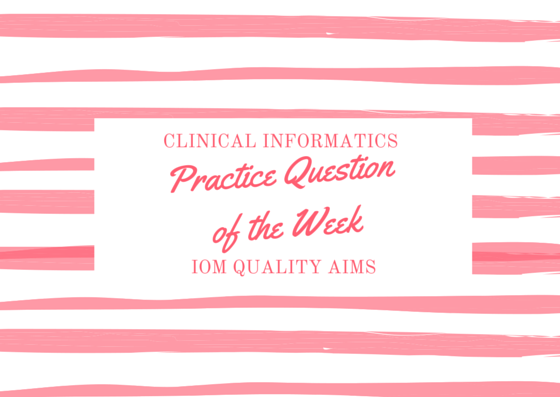This week’s question deals with the Institute of Medicine’s Quality Aims from “Crossing the Quality Chasm.”
The IOM’s quality aims serve as a base for many topics in clinical informatics. You’ll find they influence topics including metrics for quality reporting and improvement, regulations like ACA, patient satisfaction rates, and others. And of course, since they’re all listed out in the core content, you’ll probably have to know them for the exam. So, let’s get into this week’s clinical informatics practice question.
The Institute of Medicine defined six core values for all health care delivery in their “Crossing the Quality Chasm: A New Health System for the 21st Century” report. If you’re not already familiar with it, Cross the Quality Chasm is a definitive guide to quality in medicine. IOM provides the following description of the report:
“This report from the committee on the Quality of Health Care in America makes an urgent call for fundamental change to close the quality gap, recommends a redesign of the American health care system, and provides overarching principles for specific direction for policymakers, health care leaders, clinicians, regulators, purchasers, and others.
It offers a set of performance expectations for the 21st century health care system, a set of 10 new rules to guide patient-clinician relationships, a suggested organizing framework to better align incentives inherent in payment and accountability with improvement in quality, and key steps to promote evidence-based practice and strengthen clinical information systems.
Analyzing health care organizations as complex systems, this report also documents the causes of the quality gap, identifies current practices that impede quality care, and explores how systems approaches can be used to implement change.”
If you haven’t read it in a while, be sure to do so. You can find the full PDF text here.
Question
All of the following are defined as core values of quality by the Institute of Medicine except:
A. Effectiveness
B. Efficiency
C. Equity
D. Economy
Explanation and Answer
The following definitions of each of the aims are from the July 21, 2008 ACHMA Policy Incubator Series briefing “Enhancing the Quality Improvement Infrastructure for Behavioral Health.”
The six aims are:
- Patient Safety: the prevention of harm to patients.
- Effectiveness: up-to-date evidence-based services are provided in response to and respectful of individual choice and preference.
- Efficiency: human and physical resources are managed in ways that minimize waste and optimize access to appropriate treatment.
- Patient Centeredness: a highly individualized comprehensive approach to assessment and services is used to understand each individual’s and family’s history, strengths, needs, and vision of their own recovery including attention to the issues of culture, spirituality, trauma, and other factors. Service plans and outcomes are built upon respect for the unique preferences, strengths, and dignity of each person.
- Timeliness: goal-directed services are promptly provided in order to restore and sustain the integration of clients and families into the community.
- Equity: access and quality of care do not vary because of race ethnicity, age, gender, religion, sexual orientation, disability, diagnosis, geographic location, socioeconomic status, legal status.
Economy – which describes the minimizing the cost of resources is not listed as a quality aim from the IOM. Therefore, the correct answer to this question is D – Economy.
If you’re looking for other study resources, check out some of our other practice questions of the week. You can also purchase our text – Clinical Informatics Board Review: Pass the Exam the First Time. It’s the only board review book for the clinical informatics exam. It also comes with a money back guarantee if you don’t pass the exam on your first attempt – the only study material for the clinical informatics exam with one.
References:
Institute of Medicine. Crossing the quality chasm. www.iom.edu
ACMHA Policy Incubator Series (July 2008). Enhancing the quality improvement infrastructure for behavioral health.
Aspden P, Corrigan J, Wolcott J, et al., eds (2004). Patient safety: achieving a new standard for care. Washington, DC: National Academies Press.
Mitchell, P.H. Chapter 1. Defining patient safety and quality care. www.ahrq.gov
